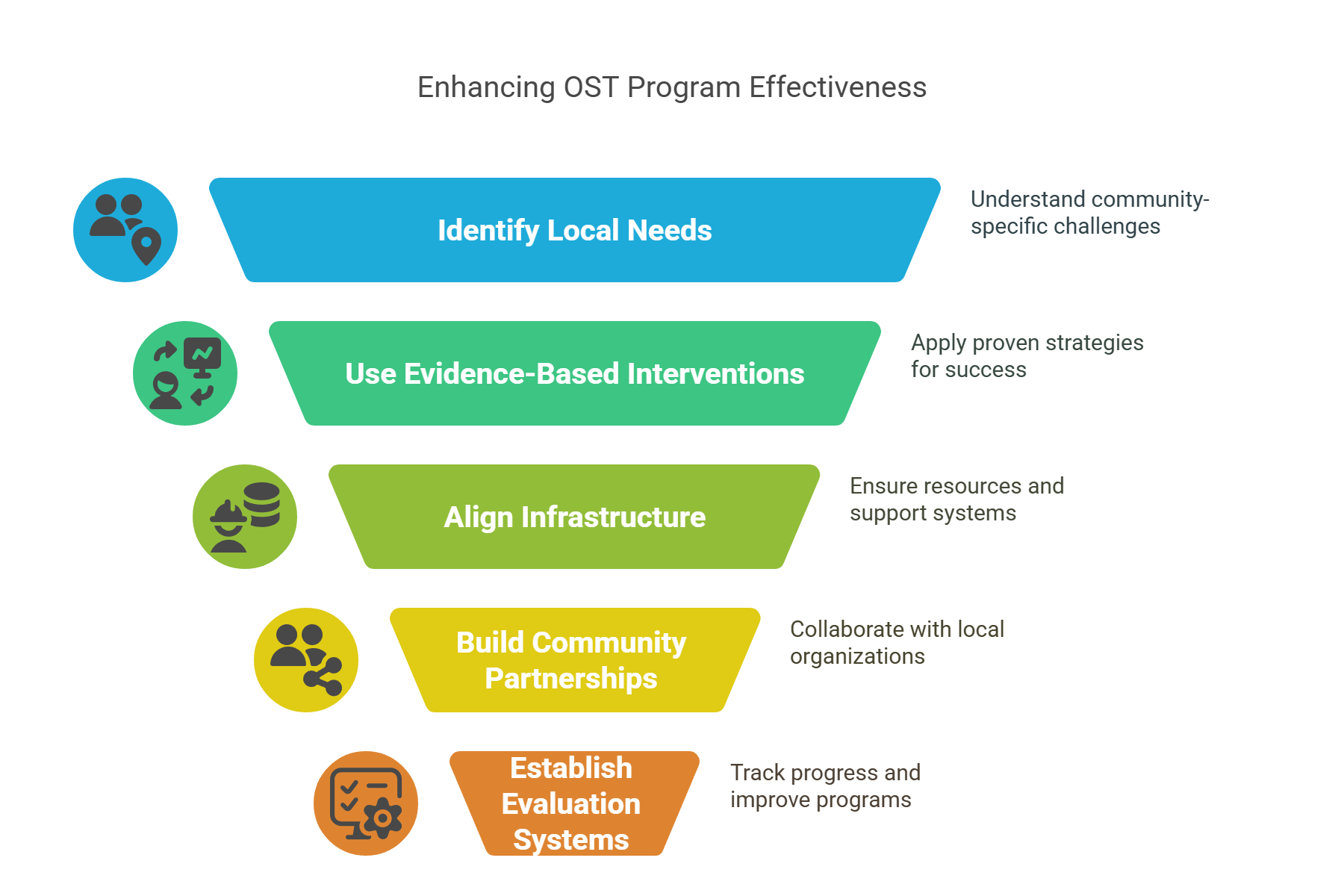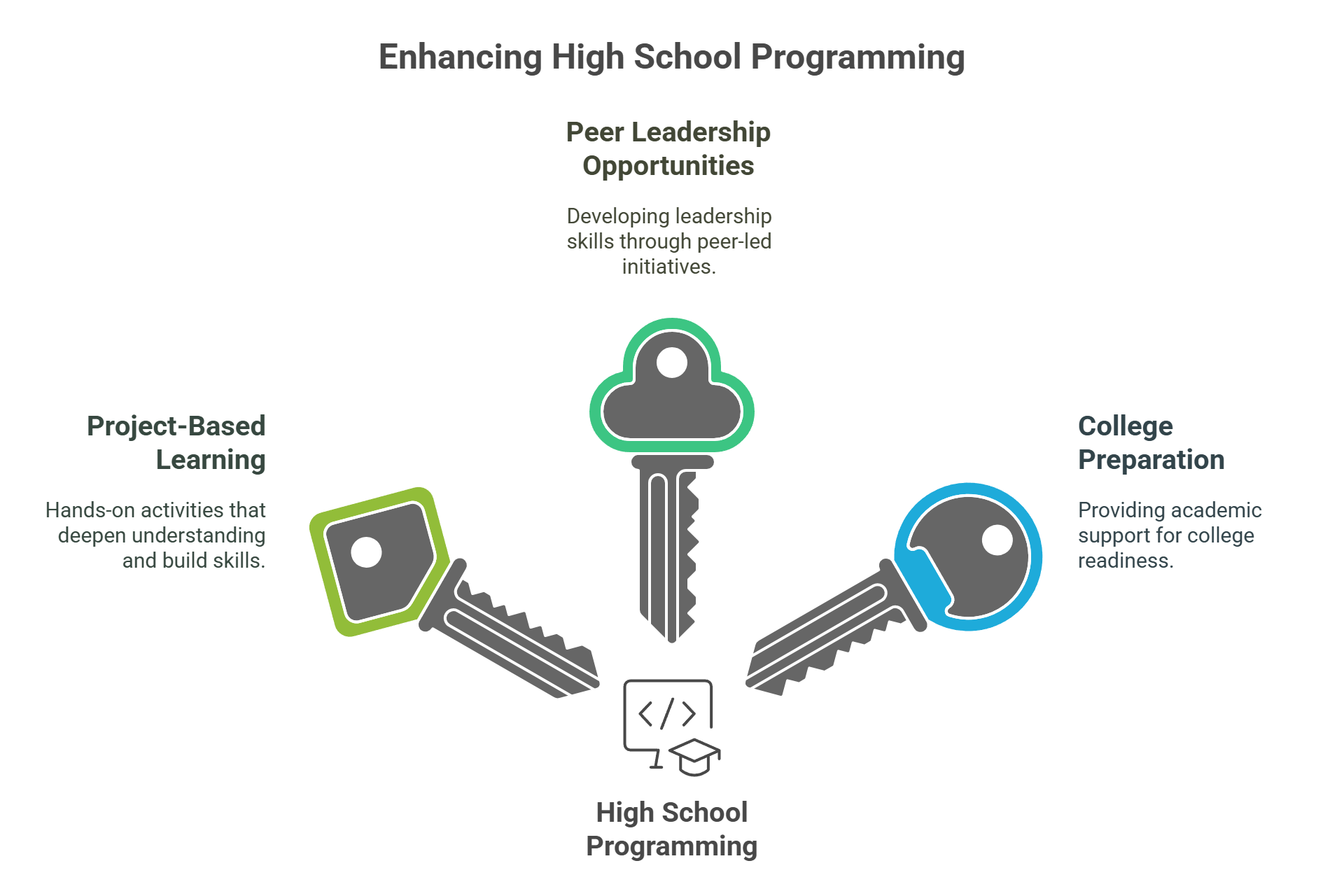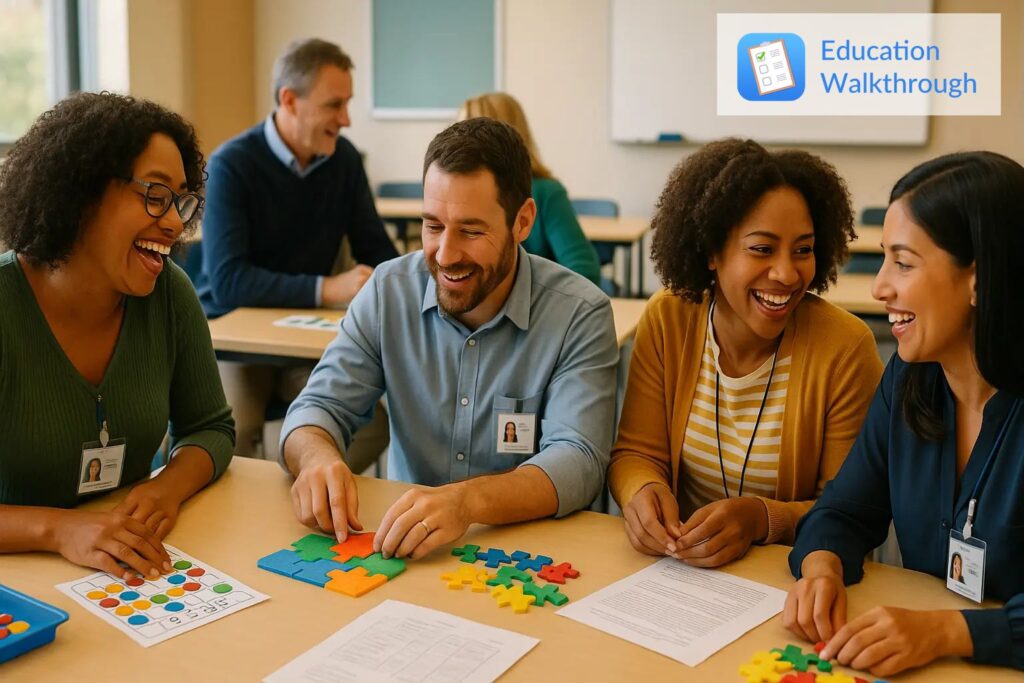Out-of-school time programs play an important role in supporting students beyond the classroom. More than just a place to stay after school, these programs help improve academic success, build important social skills, and provide a safe, engaging space for children to grow.
Whether you’re a parent or an educator, understanding how these programs work and their benefits can make all the difference.
In this article, we’ll explore everything you need to know about out-of-school time programs and how to find the right fit for your child.
Key Takeaways
- Out-of-School Time (OST) programs provide key academic, social, and emotional support for over 10.5 million children annually, particularly benefiting low-income families by addressing educational equity.
- Participation in OST programs leads to significant improvements in academic performance, social-emotional development, and students’ attitudes toward learning, contributing to better overall educational outcomes.
- Effective implementation of OST programs relies on frameworks like SAFE and community partnerships, but challenges such as staffing shortages, funding issues, and capacity limitations hinder their reach and effectiveness.
Understanding Out-of-School Time Programs
Out-of-school time programs, including after school, before school, and summer options, are a vital resource for millions of children and families. These programs step in during those crucial hours when students aren’t in the classroom, offering structured learning that supports their academic, social, and emotional growth. In fact, nearly 10.5 million children benefit from these programs each year.
What makes these programs especially important is their focus on educational equity. They provide enrichment opportunities that many low-income families might otherwise miss out on. But despite their value, challenges like cost, transportation, and scheduling often limit access, especially for families who need them most.
So, what makes an out-of-school time program truly effective? It’s one that actively involves families in shaping their children’s learning experiences. When families have a say in decision-making and goal-setting, students tend to feel more supported and engaged.
Building strong, trusting relationships with families and maintaining clear, open communication can make all the difference. How involved is your family in your child’s out-of-school learning? Taking that step can improve satisfaction and help children succeed beyond the school day.
Key Benefits of Out-of-School Time Programs

Out-of-school time (OST) programs offer a wide range of benefits that go far beyond keeping kids busy after school. Research shows that these programs play a significant role in increasing academic success, nurturing social-emotional growth, and shaping positive attitudes toward learning.
Academic Achievement
One of the most powerful impacts of OST programs is their ability to support academic achievement. A survey conducted after the COVID-19 pandemic revealed that the majority of parents find these programs helpful in improving their child’s grades and readiness for future education.
Quality OST programs often provide extra instructional time, personalized tutoring, and targeted support, especially for students who face greater challenges.
The survey also showed that students who regularly participate in OST programs can see impressive gains, with improvements of up to twenty percentile points in math and reading standardized tests. Hands-on projects, especially in high school, give students a chance to apply what they’ve learned in real-world settings, deepening their understanding and retention.
Beyond academics, these programs also encourage better school attendance and reduce behavioral issues, creating a more positive overall school experience. When families receive resources and training on how to support their children’s learning, academic performance and engagement get an extra boost.
Social-Emotional Development
OST programs do more than just improve grades, they help children grow emotionally and socially. These programs build resilience and coping skills, equipping kids to handle life’s ups and downs with greater confidence.
Participation in OST programs often leads to stronger empathy and better relationships with peers. Feeling a sense of belonging and community motivates students to stay engaged and collaborate more effectively, which are skills that many young people value deeply.
Attitudes Toward Learning
Perhaps one of the most lasting benefits of OST programs is how they shape students’ attitudes toward education. Through offering engaging, project-based learning experiences, these programs help students connect personally with what they’re studying. This connection not only deepens understanding but also makes learning more meaningful and enjoyable.
As a result, students often feel more connected to their school community and develop a stronger drive to learn. Positive attitudes cultivated through OST programs contribute to ongoing academic success and greater enthusiasm for education.
The Impact of Out of School Time on Children and Families

Out-of-school time (OST) programs make a real difference in the lives of children and their families. For kids, these programs mean more than just extra hours. With it, they enjoy better academic performance, stronger social skills, and even improvements in physical health.
Parents are noticing the benefits too: 78% say OST programs help them fulfill work commitments, while 83% of parents value the peace of mind that comes from knowing their child is safe and engaged after school.
But the positive effects don’t stop at home. OST programs strengthen communities through the following ways:
- They help reduce student absenteeism, keeping kids on track with their learning.
- By increasing youth engagement, OST programs cultivate a more vibrant, connected community.
- Structured activities and supervision provide a safe space for children to learn and grow.
- For working families, these programs are a lifeline, making it easier to balance job responsibilities with family needs.
Whether you’re a parent looking for support or a community member interested in youth development, it’s clear that OST programs offer lasting benefits for everyone involved.
Effective Implementation of OST Programs

Getting the most out of out-of-school time (OST) programs depends heavily on how well they are put into practice. Successful programs often follow structured frameworks like the SAFE approach, which stands for Sequenced, Active, Focused, and Explicit practices.
The SAFE Framework
Behind any effective OST programming is the SAFE Framework, guiding how activities are designed and delivered:
- Sequenced: Teaching social and behavioral skills step-by-step helps students grasp and remember these important lessons more easily.
- Active: Encouraging students to actively participate keeps them engaged and improves how well they retain information.
- Focused: OST programs prioritize the development of social and behavioral skills as a main goal, not just an afterthought.
- Explicit: Clearly communicating learning objectives ensures students know what’s expected, boosting their motivation and involvement.
Together, these practices create a learning environment that increases greater student engagement and a more positive experience beyond the classroom.
Five-Step Implementation Process
To make OST programs truly effective, a thoughtful five-step process is key:
- Identify Local Needs: Tailoring programs to the specific needs of the community ensures they address the right challenges.
- Use Evidence-Based Interventions: Choosing strategies proven to work in similar settings increases the chances of success.
- Align Infrastructure: Making sure the necessary resources and support systems are in place helps programs run smoothly.
- Build Community Partnerships: Collaborating with local organizations and stakeholders expands resources and strengthens support networks.
- Establish Evaluation Systems: Ongoing assessment allows programs to track progress and continuously improve.
Combining the SAFE Framework alongside this implementation process, OST programs can maximize their positive impact on students and communities alike.
Challenges Facing OST Programs

While OST programs offer many benefits, they also face significant hurdles that limit their reach and effectiveness. The main challenges include staffing shortages, funding constraints, and limited capacity, all of which make it difficult for these programs to meet the growing demand.
Let’s look at them in more detail.
Staffing Concerns
One of the biggest obstacles OST programs face is finding and keeping qualified staff. Many programs struggle with low pay and high turnover, which affects their ability to provide quality academic support and enrichment activities. In fact, 81% of program providers identify staffing as the top barrier to effective OST programming.
To tackle this, programs are focusing on better recruitment and retention strategies, such as offering competitive wages and benefits, along with training initiatives designed to attract and hold onto talent despite widespread shortages.
Funding Issues
Funding is another critical challenge. Federal support for afterschool programs has remained largely unchanged for over twenty years, leading to a significant gap between demand and available services.
Currently, for every child served, three more are waiting for access. This stark imbalance underscores the urgent need for increased funding and grants to expand program availability and ensure all children can benefit.
Capacity Limitations
Capacity constraints further limit OST program access. According to the Afterschool Alliance, nearly 25 million children would participate in afterschool programs if one were available to them, highlighting a significant gap between demand and supply. Despite this high interest, only about 10.2 million children currently attend these programs.
Furthermore, participation in academically focused OST programs remains limited, underscoring the need to expand opportunities to better support students’ learning and development.
Meeting this demand requires expanding capacity so more students can receive the support and enrichment they need.
Addressing these challenges is essential to maintain the quality, accessibility, and impact of out-of-school time programs for children and families.
Finding the Right Out of School Program for Your Child
Selecting the right Out-of-School Time (OST) program for your child involves careful consideration of their interests and goals. Parents should start by identifying programs that align with their child’s academic and personal development needs.
Resources like the Out-of-School Time Program Locator can provide tailored assistance in finding suitable programs.
It’s also important to visit potential programs and speak with staff to ensure the program’s environment and offerings are a good fit for your child. Engaging in these steps will help parents attend to make informed decisions that support their child’s growth and development.
Strategic Recommendations for Educators

Educators hold a key role in making out-of-school time (OST) programs successful. By prioritizing family engagement and aligning program goals with school objectives, they can significantly improve student outcomes.
Building strong partnerships with families and ensuring OST activities support overall student achievement are strategies that truly make a difference.
Family Engagement
Engaging families effectively strengthens the impact of OST programs. When families have chances to participate in learning activities at home and in the community, it extends the benefits beyond program hours. Offering workshops and resources that help students prepare for college applications and readiness can add even more value.
But family engagement goes deeper than just communication. It means involving families in decision-making and setting goals together. This collaborative approach creates a supportive environment that stimulates children’s academic growth and social-emotional development, paving the way for their success.
Aligning Goals with School Objectives
To maximize educational outcomes, OST program goals should align closely with those of the school. When these two work hand in hand, after-school activities reinforce what students learn during the day. Regularly reviewing how well OST goals match school objectives allows educators to fine-tune programs for greater effectiveness.
Using tools like a logic model can help plan and visualize the links between resources, activities, and expected results. That way, OST programs complement classroom learning, creating a seamless and supportive educational experience for students.
Special Considerations for High School Programming

High school students have distinct needs that out-of-school time (OST) programs must thoughtfully address. Engaging teens through project-based learning and peer leadership opportunities not only supports their academic success but also develop essential skills for personal growth and future leadership.
Project-Based Learning
Project-based learning offers high school students hands-on, experiential activities that deepen their understanding and retention of key concepts. Through these projects, students can build critical thinking, problem-solving, and collaboration skills. Many of these initiatives also include peer leadership roles, allowing students to guide their classmates and strengthen their leadership qualities.
This approach connects academic knowledge with real-world challenges, making learning more relevant and meaningful. It also provides opportunities for students to seek homework help, further boosting their understanding and confidence in subjects like science and math.
Peer Leadership Opportunities
Peer leadership opportunities within OST programs help students develop important leadership skills, which is important for them to participate in peer-led initiatives successfully. This teaches students to collaborate effectively and take on responsibilities that benefit their peers.
These opportunities help students develop critical life skills, such as communication, teamwork, problem-solving, and the importance of character building through technology recreation.
College Preparation
Out-of-School Time programs are effective in providing essential test preparation and academic support that contribute to students’ college readiness. These programs offer targeted support in test preparation and academic counseling, aiding students in their transition to higher education.
With these in place, OST programs can help students navigate the complex process of college applications, financial aid, and postsecondary options.
Policy Advocacy and Community Partnerships
Sustaining and expanding out-of-school time programs depends heavily on strong policy advocacy and vibrant community partnerships. These efforts not only help secure vital funding but also break down regulatory barriers, opening doors for more children and families to benefit.
Policy Advocacy
When advocating for OST programs, it’s essential to present clear, compelling requests to policymakers. Sharing data and success stories paints a vivid picture of the programs’ impact, making a strong case for increased funding and supportive policies. Such advocacy efforts can unlock resources, ensuring OST programs continue to excel and meet community needs.
Building Community Partnerships
Forging collaborative relationships with local organizations brings fresh resources and support to OST programs. These partnerships enrich program offerings and enable after-school initiatives to serve more children effectively. Beyond funding, community connections often provide mentorship and internship opportunities, helping youth develop necessary skills coupled with confidence.
Engaging with local businesses, nonprofits, and other stakeholders also expands funding avenues and broadens program reach. Together, these partnerships build a stronger, more sustainable foundation for OST programs, ensuring they remain a vital part of the educational community.
Summary
As we have seen, Out-of-School Time (OST) programs play a vital role in nurturing children’s academic growth and social-emotional skills. These programs offer structured learning, improve social abilities, and cultivate positive attitudes toward education, making a lasting difference for children and families.
Success depends on effective implementation, strategic educator involvement, and overcoming challenges like staffing, funding, and capacity. Strong advocacy and community partnerships further sustain and expand these critical services. And ensuring every child has access to these opportunities is a shared responsibility.
220 Youth Leadership specializes in OST programs such as leadership, financial literacy, and professional development, designed to prepare high school students with essential skills for success in work and life. Take the next step in empowering your students with proven, impactful programs tailored to their needs.
Frequently Asked Questions
What are Out-of-School Time (OST) programs?
Out-of-School Time (OST) programs offer structured learning opportunities outside of regular school hours, including after school, before school, and during the summer. These programs are designed to support children’s academic and personal development.
How do OST programs benefit children academically?
OST programs significantly improve children’s academic performance, leading to higher graduation rates and improved school attendance. Engaging in these programs can make a notable difference in children’s educational outcomes.
What challenges do OST programs face?
OST programs face significant challenges such as staffing shortages, insufficient funding, and capacity constraints, which ultimately impede their ability to serve an increasing number of participants effectively.
How can parents find the right OST program for their child?
To find the right Out-of-School Time (OST) program for your child, focus on their interests and goals, visit potential programs, and utilize resources like the Out-of-School Time Program Locator for tailored options. This approach ensures you select a program that aligns with your child’s needs.
Why are policy advocacy and community partnerships important for OST programs?
Policy advocacy and community partnerships are crucial for OST programs as they not only help secure funding and eliminate regulatory barriers but also amplify resources and support, ultimately enriching program offerings.


